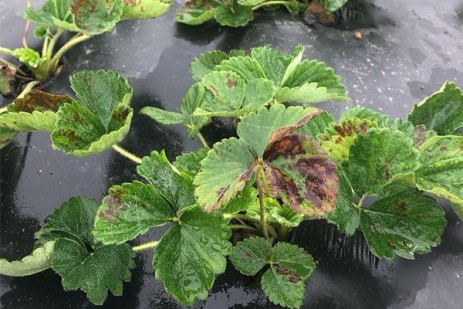However, here are some issues to be aware of, including ones that are a continuation from last year.
Frost
The problem is that when it’s both cold and windy, (as the forecast was for Wednesday night, April 21) row covers don’t provide much if any protection, and it’s difficult to get consistent coverage with overhead irrigation. When using overhead irrigation alone, damage can actually be increased as evaporation of the water drops plant blossom temperatures below that of the air temperatures. Unless your air temperature at blossom level is at or below the critical temperature for your crop’s growth stage, you will likely be better off not irrigating at all especially when you are using irrigation alone.
You can apply the water on top of row covers to get more consistent protection. Frost and Freeze Damage on Berry Crops is an article from 2020 that discusses critical temperatures for different berry crop growth stages and frost control options.
Neopestalotiopsis
This disease is having some really bad effects this year as the weather warms down south. Before I send you all into a panic though, I do want to point out that most foliage diseases we saw last fall were our more typical problems, even in plasticulture plantings where runner tips originated from the source in question. We are hoping there are no additional plantings with issues beyond those identified last fall, but who knows?
The hallmark of Neopestalotiopsis is the rapid development of tan blotches on leaves that quickly overtake the healthy foliage, plant death, and lesions on strawberry fruit. Tiny black dots appear within a few days within the leaf and fruit lesions. Last year, we had hoped that the problem was caught early and that infected plants were discarded, but it became apparent that some infected plants of Sweet Charlie and Chandler (primarily) made it into grower fields, mainly on plug plants sold later in the late summer/early fall plug planting season.
Last fall, affected growers were advised to remove any foliage with symptoms and make fungicide applications, which seemed to help quite a bit. We hope this spring that with diligence and meticulous sanitation, the problem can be minimized. Inoculum could potentially be spread by hand, so removal of leaves with symptoms should take place in the least affected areas of the field first, during dry weather, and later in the day when the foliage has dried. Any plant material should be bagged and removed completely from the field, and not be composted. Thiram is somewhat effective, and has a 2(ee) label; Switch has some effectiveness, too. Repeated applications will likely be needed.
New species of botrytis/gray mold?
Besides our typical species Botrytis cinerea, there may be a new one on strawberries – Botrytis fragariae, which may have greater resistance to one of the active ingredients in Switch. Mengjun Hu from the University of Maryland is interested in obtaining samples from grower farms to determine how widespread this new species is in the area and the degree of fungicide resistance that exists. More to follow on that at a later date.
Phytophthora crown rot on ‘Flavorfest’
I’m continuing to get reports of plantings that are collapsing from Phytophthora crown rot. If you have Flavorfest, and plants are collapsing, cut through some crowns to see if you can find any brownish discoloration. Ridomil through the drip is best, and Aliette and foliar sprays of a phosphonite material should help. In some cases where plants had been declining all winter, it’s questionable whether treatment this spring is worthwhile. Other diseases like crown anthracnose or winter injury can cause similar symptoms on a wide range of cultivars, so in this case, we are focusing on Flavorfest in plasticulture plug plantings.
Getting updates
Wondering what you can use to protect your fruit crops, including strawberries and blueberries? If you have a smartphone, check out the myIPM app available in the Apple Store and on Google Play for no charge. More info can be found at MyIPM Smartphone App Series. Developed and designed by Guido Schnabel (Clemson University), Mengjun Hu (University of Maryland), and Brett Blaauw (University of Georgia), the app is being updated and maintained by fruit specialists at Cornell University, the University of Massachusetts, Penn State University (Kari Peter and Greg Krawczyk), the University of Maryland (Mengjun Hu), North Carolina State University, and the University of Georgia.
If you are more inclined to get info via phone, the 1-800-PENN-IPM line for berry crops is up and running with alerts and updates provided on a weekly basis this year, so you can dial in and find out what the current issues are. With only 90 seconds available for the recording, there may not be time to provide a lot of detail on all topics, but at least you’ll have a heads-up on the most important current ones.

















